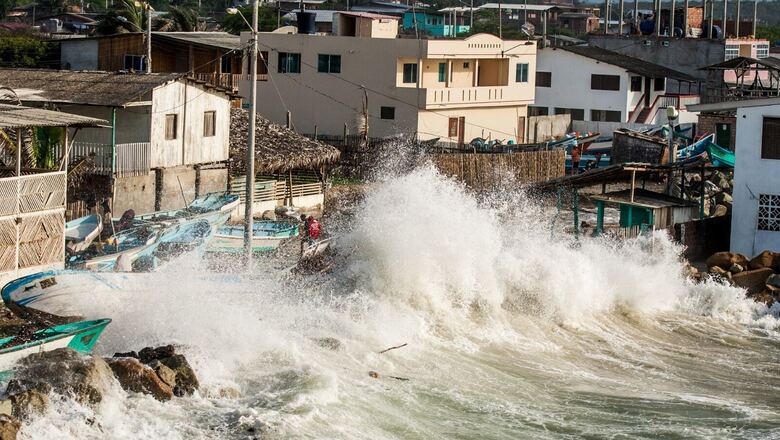
views
A report curated by the Intergovernmental Panel on Climate Change (IPCC) on Monday ringed alarm that several disasters induced by climate change are likely in the next two decades even if greenhouse gas emission is reduced. From heat passing the limits of human survivability, food and water scarcity, higher sea levels to severe economic damage, India will be seriously harmed if emissions are not cut, the second installment of the IPCC report said.
While placing India at the high-risk zone, the IPCC report also noted that over 3.5 billion people or 45 per cent of the global population was living in highly vulnerable areas in terms of climate change. The report also noted that the ability of human beings as well as natural ecosystems was being tested and further rise in global warming will make it more difficult for them to adapt.
What are IPCC Reports?
The latest IPCC report is the second part of the Sixth Assessment Report that lays focus on climate change impacts, risks and vulnerabilities and explores options to adapt. The first part was released in August 2021, and talked about the scientific basis of climate change. IPCC will release its third and final part of the report in April this year according to reports.
The first Assessment Report by IPCC had come out in 1990. These thousands-pages long reports are comprehensive assessments of the state of the earth’s climate, which are published by experts after collecting every relevant information and collating them to understand the impact. The reports, which were released in 1995, 2001, 2007 and 2015 form the basis of the global response to climate change.
What’s Unique This Time?
While the Sixth Assessment Report does not say anything new about climate change, the IPCC for the first time has included regional and sectoral impacts of climate change as part of expanding the scope of its assessment. The reports usually build up on the previous assessments, and this time too it has done so. For example, the report has stated Mumbai to be affected by sea-level rise, while placing Kolkata at risk of storms. This was not done in previous reports and provides a clearer vision on what needs to be done regarding these threats.
Climate change and related extreme events will significantly increase ill health and premature deaths from the near- to long-term, the report has also found. It also says that vector-borne diseases like dengue and malaria will increase. Mental health challenges, including anxiety and stress, are expected to increase under further global warming in all assessed regions, particularly for children, adolescents, elderly, and those with underlying health conditions, it says. These health impacts were not covered in the preceding reports.
What are the Other Findings?
The report cautioned that climate-related risks to agriculture and food systems in Asia will progressively escalate with the changing climate, with differentiated impacts across the region. In India, rice production can decrease from 10 to 30 per cent whereas maize production can decrease from 25 to 70 per cent assuming a range of temperature increase from 1 degree Celsius to 4 degree Celsius, it said.
Referring to wet-bulb temperatures, a measure that combines heat and humidity, the report warned that if emissions continue to rise, wet-bulb temperatures will approach or exceed the unsurvivable limit of 35 degrees C over much of India, with the majority of the country reaching wet-bulb temperatures of 31 degrees C or more. A wet-bulb temperature of 31 degrees C is extremely dangerous for humans, while a value of 35 degrees C is unsurvivable for more than about six hours, even for fit and healthy adults resting in the shade. Currently, wet-bulb temperatures in India rarely exceed 31 degree C, with most of the country experiencing maximum wet-bulb temperatures of 25-30 degree C,” said the IPCC report.
The report said that both climatic and non-climatic drivers such as socio-economic changes have created water stress conditions in both water supply and demand in all sub-regions of Asia. the international transboundary river basins of Amu Darya, Indus, Ganges and inter-state Sabarmati-river basin in India could face severe water scarcity challenges with climate change acting as a stress multiplier.
According to the report, high levels of warming could cause a global GDP decline of 10-23 per cent by the end of the century, compared to a world without warming. Several major economies could see even larger economic declines because of climate change, with a study cited in the report estimating GDP losses by the end of the century of up to 42 per cent in China and 92 per cent in India, if emissions are high.
What Needs to be Done Now?
While IPCC Assessment Report does not direct states and countries what to do, it forms the basis of many policymaking decisions that governments refer to. They come in of help in ideating actions related to climate change despite not being directive in nature. IPCC reports only find scientific evidences and present factual situations. The reports also form basis of global climate change negotiations like the Paris Agreement. Governments and international agencies are now likely to refer to these findings to place their policy changes regarding climate.
Read all the Latest News India and Breaking News here
















Comments
0 comment